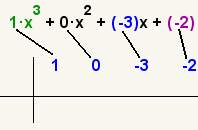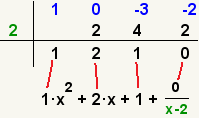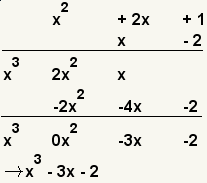Synthetic Division
Pronunciation: /sɪnˈθɛt.ɪk dɪˈvɪ.ʒən/ ExplainSynthetic division is an algorithm for quickly dividing polynomials when the divisor is in the form x - r. Synthetic division is formally called Ruffini's rule. Synthetic division is commonly used to verify roots of a polynomial.
| Step | Equation(s) | Description |
|---|---|---|
| 1 |  | This is the dividend. |
| 2 |  | This is the divisor. |
| 3 |  | This is the operation that will be performed. |
| 4 |  | Identify the implied coefficients and fill them in. Applying the property of multiplying by 1 to the term x3 gives an implied coefficient is 1. Notice that there is no term x2. Applying the property of multiplying by 0 then the property of adding 0 to the x2 term gives 0 · x2. |
| 5 |  | Copy the coefficients into the top of a grid. |
| 6 |  | Copy the additive inverse of the constant term of the divisor\ into the grid on the left. |
| 7 |  | Copy down the coefficient of the term with the largest degree. In this case, the coefficient is 1. |
| 8 |  | Multiply the first number on the bottom by the number on the left. Place the result in the 2nd row, the next column to the right. |
| 9 |  | Add the numbers in the first two rows of the next column. Place the result in the 3rd row. |
| 10 |  | Multiply the number on the 3rd row of the current column by the number on the left. Place the result in the 2nd row, the next column to the right. |
| 11 |  | Add the numbers in the first two rows of the next column. Place the result in the 3rd row. |
| 12 |  | Multiply the number on the 3rd row of the current column by the number on the left. Place the result in the 2nd row, the next column to the right. |
| 13 |  | Add the numbers in the first two rows of the next column. Place the result in the 3rd row. |
| 14 |  | Multiply the number on the 3rd row of the current column by the number on the left. Place the result in the 2nd row, the next column to the right. |
| 15 |  | Copy the coefficients of the result into a polynomial. |
| 16 |  | Simplify the polynomial. |
| 17 |  | Here is the problem with the result. |
| 18 |  | Check the work by multiplying the\ result by the divisor. |
| Example 1 | ||
References
- McAdams, David E.. All Math Words Dictionary, synthetic division. 2nd Classroom edition 20150108-4799968. pg 174. Life is a Story Problem LLC. January 8, 2015. Buy the book
More Information
- Stapel, Elizabeth. Synthetic Division: The Process. Purplemath. 3/12/2009. http://www.purplemath.com/modules/synthdiv.htm.
Cite this article as:
McAdams, David E. Synthetic Division. 5/7/2019. All Math Words Encyclopedia. Life is a Story Problem LLC. https://www.allmathwords.org/en/s/syntheticdivision.html.Image Credits
- All images and manipulatives are by David McAdams unless otherwise stated. All images by David McAdams are Copyright © Life is a Story Problem LLC and are licensed under a Creative Commons Attribution-ShareAlike 4.0 International License.
Revision History
5/7/2019: Changed equations and expressions to new format. (McAdams, David E.)12/21/2018: Reviewed and corrected IPA pronunication. (McAdams, David E.)
12/10/2018: Removed broken links, updated license, implemented new markup. (McAdams, David E.)
8/7/2018: Changed vocabulary links to WORDLINK format. (McAdams, David E.)
1/30/2009: Initial version. (McAdams, David E.)
- Navigation
- Home
- Contents
-
# A B C D E F G H I J K L M N O P Q R S T U V W X Y Z - Teacher Aids
- Classroom Demos
- How To
- LIASP
- LIASP Home
- Conditions of Use
- Privacy Policy
- Donate to LIASP
- Help build this site
- About LIASP
- Contact LIASP
All Math Words Encyclopedia is a service of
Life is a Story Problem LLC.
Copyright © 2018 Life is a Story Problem LLC. All rights reserved.
This work is licensed under a Creative Commons Attribution-ShareAlike 4.0 International License